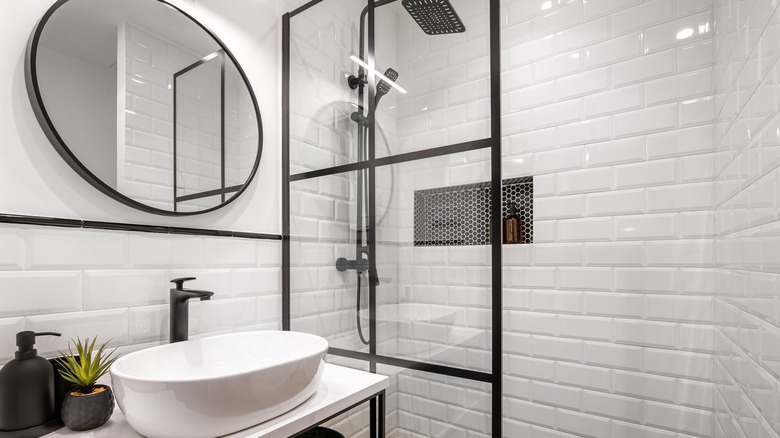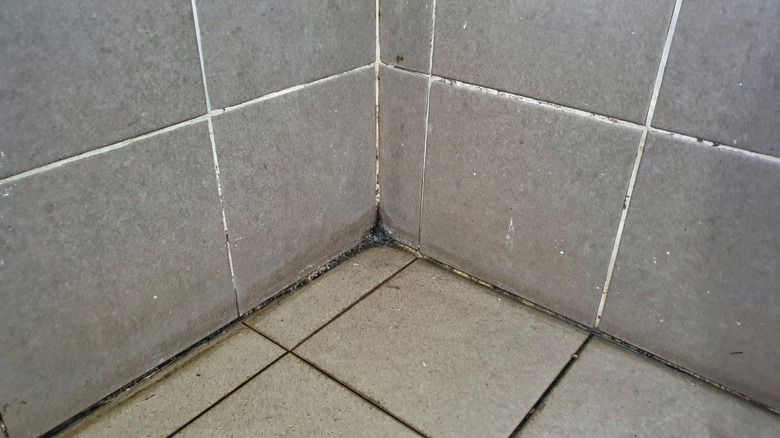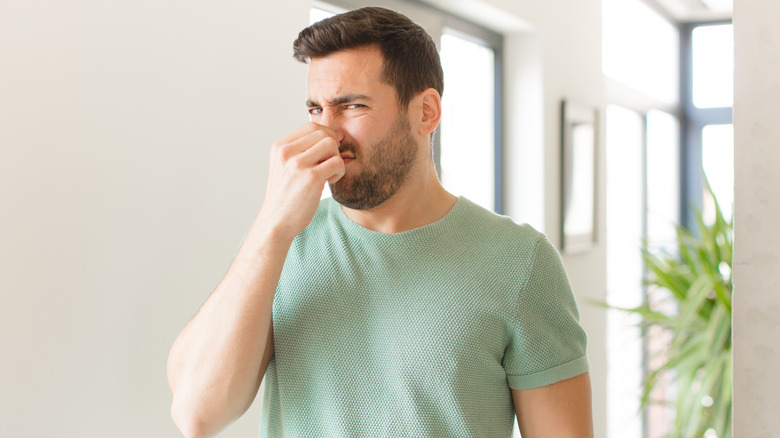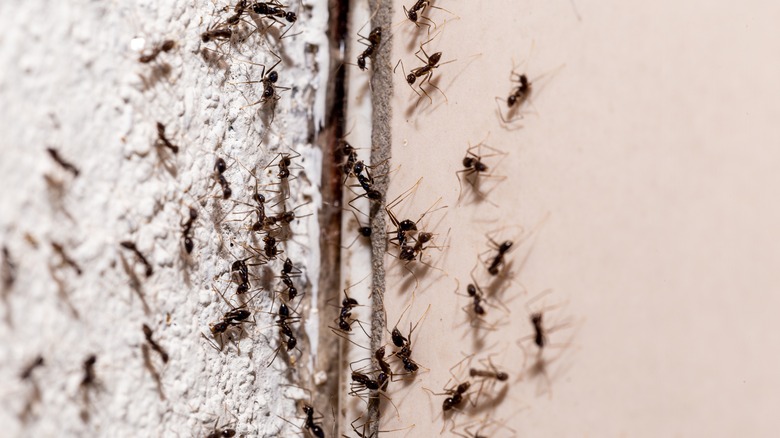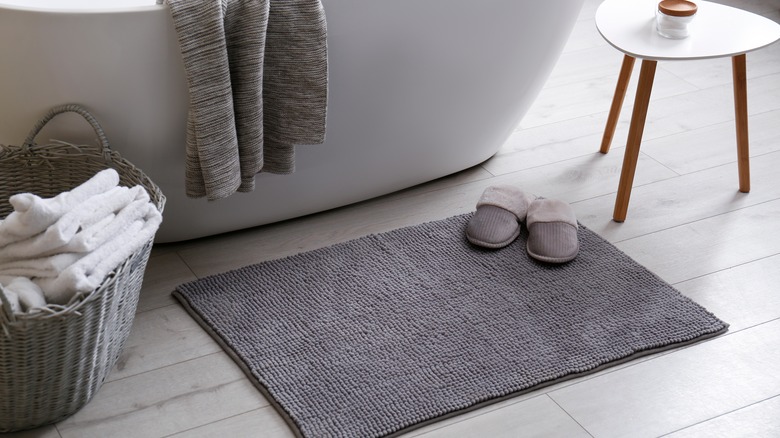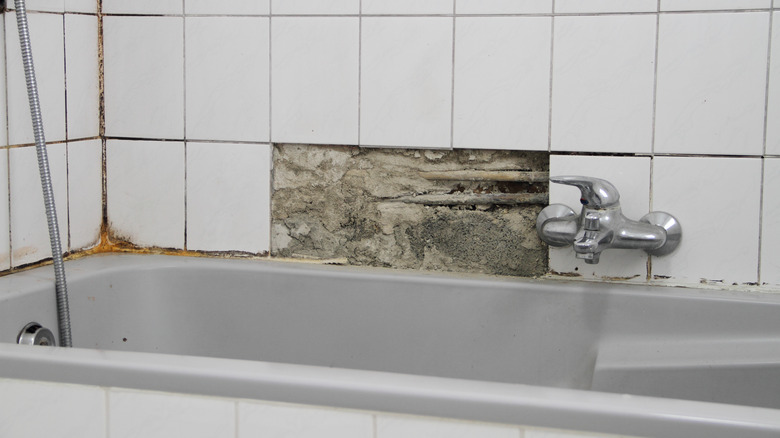5 Signs Your Shower Is Full Of Hidden Mold
Mildew and showers, unfortunately, make a good match. Between the steam, the water and ever-present wetness, the area becomes a perfect place for mold or other fungi to grow. "Mold was here before we were on the planet, it'll be here after us," said Dr. Sophia Tolliver, a family medicine physician in Ohio, to TODAY. "Definitely, the bathroom is ground zero, if you will, for mold growth, probably because mold likes to grow in dark, damp areas."
According to the U.S. Environmental Protection Agency, mildew can find a home in any place with high moisture, including basements, attics, windowsills, and showers. You want to rid your home of this since exposure to the substance can cause or exacerbate allergies, asthma, and other respiratory problems. You can do a few things to help the situation, such as venting rooms with lots of moisture, installing air conditioners or de-humidifiers, or using exhaust fans when possible. You can also prevent water from accumulating by installing insulation on areas that typically remain cold, such as windows in your shower. Always ensure that humidity never hits more than 50% in your home. Another thing you can do is dry any wetness within a day or two to stop any growth from accumulating.
Any time you spot mold or any other fungus, you'll need to remove it ... but first, you have to identify it. Read further to discover whether or not your shower houses mildew so you can stop the problem ASAP.
1. Colored spots appear on your shower
For some homeowners, mold is an obvious problem since it visibly decorates your shower's walls, doors, and ceiling. Mold often starts developing underneath things — so if you are seeing it on tiles or glass, you've probably had the problem for a while, according to Best Pick Reports. Most of the time, you'll see grey, black, or dark brown growths along your shower, creeping along the caulking or walls. Mold can also appear in other hues, such as green, white, or blue. Its texture may seem fuzzy or wooly, with some varieties appearing with a slimy cast.
Molds that typically thrive in the bathroom area include Aspergillus, Cladosporium, Penicillium, and the dreaded Stachybotrys, or black mold, reports TODAY. Most of these appear a darkish brown or green, with Penicillium taking on a yellowish or blue tint. Black mold is aptly named since its coloring looks brackish. Telling the difference between these types is difficult, but most of these varieties require the same treatment: removal. This might entail cleaning the area with ingredients such as white vinegar, ammonia, baking soda, hydrogen peroxide, chlorine bleach (or sometimes a combination of materials — just never mix ammonia and bleach), or a commercial cleanser, says Reader's Digest. While working, be sure to keep the area ventilated and to protect yourself with rubber gloves. Sometimes, you might even need to replace sections such as the caulking. Black mold might require a professional since its spores can be harmful.
2. A musty smell might mean you have mold
Since mildew grows underneath things, you might not see its marks in your bathroom at first. Mold and mildew like dark, wet spaces and might fester behind the tiles of your shower or up in the ceiling's panels before it shows obvious evidence of its presence, says Best Pick Reports. As mold's spores decompose, it gives off an earthy or musty odor. Something like a small leak in a shower can create a problem since moisture gathers around the area and creates the perfect situation for mildew and mold growth.
But don't fret yet. There are a few solutions to this problem. For instance, if your shower drain gives off that stale smell, you can try pouring baking soda into it, followed by some white vinegar. Once you've completed that step, boil a pot of water and let that go into the drain as well, according to Shower Plus Bath. Not only should this stop the funky odor, but the mildew should disappear, too. If the smell returns later, your shower drain might require another cleaning. Try using the same method again or up the ante with a mixture of bleach and white vinegar instead. If that doesn't work, the lingering smell might signal a deeper problem. Perhaps your drain is blocked or clogged, or maybe the mold is too rampant for DIY. At any rate, it might be time to call in a plumber to fix the situation.
3. Ants in your shower
Something ants have in common with mildew and mold is their love of all things moist. A telltale sign that you might have fungus growing beneath the surface of your shower is the appearance of ants crawling around its wall, ceiling, or glass, reports Insect Cop. In fact, lots of insects like those mold spores. Carpenter ants, for example, don't eat mold, but like that it helps weaken wood, making it easier for them to settle in and build their nests within your home — and that is something you definitely don't want.
Mold breaks down things like wood and drywall, allowing cracks to form within walls that allow bugs to get in. Plus, ants already like the bathroom as a place to hang out. It is full of delicious odors, said Kylor Powell. For example, those strings of hair and bits of dead skin that collect near the drain ferment and attract them. Ridding the shower of ants usually just requires a spray of vinegar and water (use a 50/50 composition in a bottle). Getting rid of the mildew and mold that lies underneath is another matter, and you'll need to address that problem as well. If it is not in an area that you can clean easily, you might need professional help.
4. A soft floor
It's natural to walk around your bathroom barefooted. But, if the floor feels soft and spongy as you wander around the shower, that is not normal. This is something that you should explore much further. The pliability of the flooring could indicate a problem with the subfloor like it's rotting away or weakening after repeated moisture exposure. Perhaps, even mold has taken root, says Modern Bathroom. Things like a leak can cause this. You should examine the area and see what else you notice. Is there a musty smell? Do you see any warping near the walls? Are there any gaps in the caulk or tile? Do you see any signs of mold or mildew? There is always a reason if the floor is softening.
When spots on the floor become soft, it's probably time to bring in a professional to assess the damage and advise you on the next step. While DIYers might want to fix the problem, it is a big job that entails several complex steps, including turning off the water valve, doing some demolition so you can inspect the area, and removing the damaged materials (and the mold, of course) before you begin re-building the space. Don't hesitate to act when water damage is involved, as it only will get worse with time.
5. Wall damage
Problems like mildew can arise whenever something happens to the wall in your shower. Much can go wrong in a shower: tiles break or become loose, caulk and grout wear away, and time and usage just require general maintenance. Any of these problems can allow water to go where it shouldn't, and suddenly an abundance of moisture attacks your shower.
If you see warped areas, loose tiles, or a muddy cast, that is a warning sign that something might be going on, advises Nationwide Restorations. If the shower becomes slimy, that is also an indicator that mold might be growing behind the tiles. You should also pay attention to any chipping paint, wall discoloration, or plaster damage. All of these things point to a potential problem. When the mold seems invisible, you might consider bringing an expert in, either a plumber to assess the situation or a professional mold removal company.
Take comfort, though, that often mold eradication can be DIY. If you can find the moisture problem, fix it and clean out the mold or mildew, according to Branch Environmental. What's the difference between the two? Mildew typically remains on the surface of things. Mold actually takes over the source it grows up — so complete removal is necessary; otherwise, it will come back and continue damaging your drywall, ceilings, walls, etc. There are a variety of methods to clean away mold and mildew. Always take precautions and wear an N-95 respirator, eye protection, and gloves.
